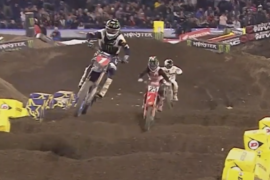“Cooksey’s Hard Truth” presented by Scott Sports is a weekly editorial written by Chris Cooksey. Chris will be diving in and out of controversial subjects and bringing you his hard truth about the racing and the riders from around the world of Supercross and Motocross.
I start this article with great difficulty as the details of Tyler Evans‘ death have since emerged. I can’t stop thinking about the pain and anguish he must have endured before ending his life. I contacted someone close to the family to give my condolences and reminisce about his racing career. The person I spoke with believed that symptoms of a brain injury played a significant role in his death along with other contributing factors. While I don’t believe there is one solution to fix everything, I do believe a combination of awareness and treatment is a step in the right direction.
I have agreed to participate in Transcranial Magnetic Stimulation (TMS) therapy by HPR Treatment Center and share a part of myself I normally keep private with the hopes of bringing awareness. I have officially begun my TMS and have logged 5 days of treatment. My journey began at the HPR Treatment Centers located at 9053 S Pecos Rd, Suite 2910, Henderson, NV.
When asked how TMS treatment works, I have found that HPR Treatment Centers explain the process best. Here is a description of the treatment directly from hprtc.com:
Mood is regulated by a region of the brain called the prefrontal cortex. In some people, the cells in this part of the brain become less active. This can be triggered by a traumatic event, or by physical changes that alter brain chemistry. Reduced activity makes it harder for your brain to regulate your mood and mental health. This can lead to major depressive disorder. TMS therapy works by stimulating the cells in your prefrontal cortex with electromagnetic pulses delivered by an electromagnetic coil. When prefrontal cortex cells are treated in this way, their activity levels return to normal. The cells become more effective at regulating your mood. This reduces or eliminates your symptoms of depression.
I am one week into my treatment and can already feel a difference. The treatment is very simple. Rhonda Davis at the HPR Treatment Center is like an angel. She might be the kindest person I have ever met. She places the TMS machine on my head (literally an electromagnetic coil as described above) and we chat for about 20 minutes while the coil delivers electric pulses to my brain. Some people may feel a slight discomfort. I felt this on a mild level, but nothing that is comparable to the pain my body has endured on the track. HPR closely monitors my progress, making sure I am not experiencing any headaches or side effects. After the first couple of treatments I had a slight headache — nothing a couple of Excedrin could not fix, and I am also prone to migraines. The treatment consists of 30 sessions (five days a week for six weeks), with each session lasting approximately 30 minutes.
After one week of treatment I am able to think more rationally and my depression manifests as a milder anger that I am now in control of. On Sunday I had a disagreement with my wife, and what previously could have been a three-day emotional slugfest was resolved within an hour or so. In life, we all have disagreements, but I think we can agree when emotion enters the picture, logic exits stage left. With my newfound brain connections, I was able to logically process my anger and be a part of the solution. My wife actually teared up; she could see a difference in me. I also want to be real here: just because I am more in control of my feelings does not mean my life is all unicorns and rainbows. I have some emotional development to work through, but where I was in black and white, I am now in color.

I have 25 sessions to go, and if I can simply maintain the progress of this first week, I will consider TMS therapy a smashing success. Depression can feel like the world is collapsing in on you, but finding TMS therapy means there is hope for me and many others who are also silently suffering.
After extensively researching both brain injuries and TMS therapy, I am convinced TMS therapy is extremely beneficial for patients who have sustained multiple concussions and who suffer from depression. If you tear your ACL, we all know rehab alone will not re-attach the ligament. Imagine a doctor telling an athlete to suck it up and to continue their rehab over and over until the ACL reattaches itself. That would never happen. Why do we think talk therapy alone will heal our brain? Some brain injuries need TMS therapy in order jump start damaged neuro pathways. With my first week down, I hope to report to continued positive outcomes in the coming weeks.
You can find more information about TMS therapy at www.hprtc.com




